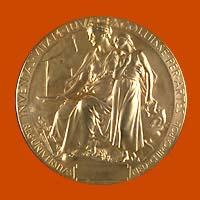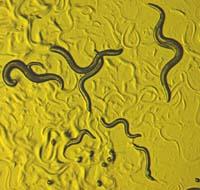The silence of genes in the Nobel Prize in Physiology or Medicine
2006/10/02 Galarraga Aiestaran, Ana - Elhuyar Zientzia

This year's Nobel Prize in Physiology or Medicine is aimed at researchers Fire and Mello. (Photo: Nobel Foundation)
Proteins, lipids, glycosides. These are the components of living beings, together with water and other elements present in small quantities. All are necessary, essential, but if you want to highlight some of them, maybe the proteins are selected, since they are protagonists of many processes. Digestive enzymes, receptors that receive signals in the brain, and antibodies that protect us against bacteria are proteins.
The mechanism of production of proteins is not simple. The information for the production of proteins is found in the cell nucleus, the DNA. Proteins are produced outside the nucleus, in cytoplasm. The intermediation between DNA and the protein production machine is performed through messenger RNA (RNAm). Precisely the prestigious Nobel Prize winner Francis Crick exposed the core of the mechanism.
Degradation of the RNA

For their part, Fire and Mello have been awarded for clarifying one of the aspects of this mechanism. This work was published in 1998. In his study, he explained how the RNA is degraded from a given gene. As a result of this degradation, the RNAm molecule disappears, so the corresponding gene is either inactive or "calla" and the protein encoding the gene is not produced.
This breakdown mechanism is called RNA interference, i.e., blockage or obstruction by RNA, and occurs when the RNAm molecules appear bent in the cell. In fact, DNA is called double propeller because it has two strands or chains that adopt that aspect. The RNAm molecule has a single thread. But sometimes it appears bent and is then when the degradation occurs.
The degradation of RNA occurs in plants, animals and humans. This mechanism is really important since it allows to control the expression of the genes.
The footprint given them by the movement of C. elegans

His research was carried out with nematodes C. elegans. (Photo: Rutgers University)
The researchers Fire and Mello used the worm Caenorhabditis elegans to clarify the mechanism. They investigated gene expression. The worm was injected with RNAm corresponding to a muscle protein and did not experience any changes in the worm movement. Then the reverse RNA was injected into that RNA and the same thing: nothing happened. On the contrary, injecting the two RNAm at a time, they saw that the worm made strange movements. It is the same movement made by worms with a lack of a gene.
Hence, it was deduced that the double chain of RNAm has the capacity to block the gene, so this strange movement is explained why the protein needed to move normally was not produced.
The researchers advanced and managed to explain how this happens. In fact, it was shown that the double string of RNAm degrades the RNAm of a single string. In addition, they knew that the mechanism is specific, that it can extend from the cell to the cell and that it can be hereditary. To achieve the effect, it was considered sufficient to inject very small amounts of double chain of RNAm and it was proposed that RNA interference is a catalytic process. Currently the process is called RNA.
New opportunities for new opportunities

RNA is an important process to protect against viruses, especially in the simplest organisms, and it is also important to control the fragments of DNA called trasposon. These DNA fragments are mobile and can be located anywhere in the DNA. If they are in a wrong place they cause damage. The RNA protects the DNA from the trasposones.
Taking a step further, RNA can be applied to genetic technology. The researchers have managed to create double RNAm chains to degrade certain RNAm and thus silence the corresponding gene.
In the future they hope to apply this technique both in Medicine and Agriculture. For example, in animals they have managed to silence a gene associated with high blood cholesterol levels, degrading RNA. Later, it is expected to treat diseases of the circulatory apparatus, cancer, endocrine diseases, viral infections and other rna-based diseases.




